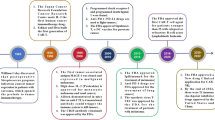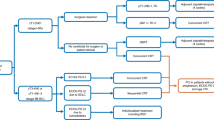Abstract
Relevant animal models for metastasis of osteosarcoma is needed to understand the biology and to develop the treatment modality of metastasis of human osteosarcoma. Therefore, we screened six human osteosarcoma cell lines for metastatic ability in nude mice. The HuO9 cell line was identified as being metastatic to the lung after intravenous injection. We established two sublines, HuO9-M112 and HuO9-M132, with high metastatic potential to the lung from the parental HuO9 cells by in vivo selection. There were no differences between these two sublines and the parental cells in the growth rate in vitro and the tumorigenicity after subcutaneous injection in nude mice, however, mice injected with the metastatic sublines became moribund earlier than mice injected with the parental HuO9 cells did. Thus, adriamycin (ADR) and recombinant interleukin-12 (IL-12) were administered to mice injected with the HuO9-M112 subline to suppress experimental lung metastases. Production of lung colonies was significantly suppressed and the prognoses of mice were significantly improved by both ADR and IL-12 treatments. These results indicate that both ADR and IL-12 are effective agents against pulmonary metastatic osteosarcoma, and that these sublines are useful for studies on the biological behavior and treatment of pulmonary metastatic osteosarcoma.
Similar content being viewed by others
References
Link MP, Goorin AM, Miser AW et al. The effect of adjuvant chemotherapy on relapse-free survival in patients with osteosarcoma of the extremity. N Engl J Med 1986; 314: 1600–6.
Eilber F, Giuliano A, Eckardt J et al. Adjuvant chemotherapy for osteosarcoma: a randomized prospective trial. J Clin Oncol 1987; 5: 21–6.
Supplementary information is available at http://cancernet.nci.nih.gov/Cancer_Types/Osteosarcoma.shtml
Meyers PA, Heller G, Healey J et al. Chemotherapy for nonmetastatic osteogenic sarcoma: The Memorial Sloan-Kettering experience. J Clin Oncol 1992; 10: 5–15.
Souhami RL, Craft AW, Eijken V et al. Randomised trial of two regimens of chemotherapy in operable osteosarcoma: A study of the European Osteosarcoma Intergroup. Lancet 1997; 350: 911–7.
Provisor AJ, Ettinger LJ, Nachman JB et al. Treatment of nonmetastatic osteosarcoma of the extremity with preoperative and postoperative chemotherapy: A report from the Children's Cancer Group. J Clin Oncol 1997; 15: 76–84.
Khanna C, Prehn J, Yeung C et al. An orthotopic model of murine osteosarcoma with clonally related variants differing in pulmonary metastatic potential. Clin Exp Metastasis 2000; 18: 261–71.
Mori S, Ueda T, Kuratsu S et al. Suppression of pulmonary metastasis by angiogenesis inhibitor TNP-470 in murine osteosarcoma. Int J Cancer 1998; 61: 148–52.
Asai T, Ueda T, Itoh K et al. Establishment and characterization of a murine osteosarcoma cell line (LM8) with high metastatic potential to the lung. Int J Cancer 1995; 76: 418–22.
Honoki K, Tsutsumi M, Miyauchi Y et al. Increased expression of nucleoside diphosphate kinase/nm23 and c-Ha-ras mRNA isassociated with spontaneous lung metastas is in rat-transplantable osteosarcomas. Cancer Res 1993; 53: 5038–42.
Honoki K, Mori T, Tsutsumi M et al. Heterogeneous pattern of gene expression in cloned cell lines established from a rat transplantable osteosarcoma lung metastatic nodule. Cancer Lett 1998; 127: 221–8.
Barroga EF, Kadosawa T, Okumura M et al. Establishment and characterization of the growth and pulmonary metastasis of a highly lung metastasizing cell line from canine osteosarcoma in nude mice. J Vet Med Sci 1999; 61: 361–7.
Vihinen P, Riikonen T, Laine A et al. Integrin α2β1 in tumorigenic human osteosarcoma cell lines regulates cell adhesion, migration, and invasion by interaction with type I collagen. Cell Growth Differ. 1996; 7: 439–47.
Scotlandi K, Manara MC, Serra M et al. The expression of P-glycoprotein is causally related to a less aggressive phenotype in human osteosarcoma cells. Oncogene 1999; 18: 739–46.
Jia SF, Worth LL, Kleinerman ES. A nude mouse model of human osteosarcoma lung metastases for evaluating new therapeutic strategies. Clin Exp Metastasis 1999; 17: 501–6.
Berlin O, Samid D, Donthineni-Rao R et al. Development of a novel spontaneous metastasis model of human osteosarcoma transplanted orthotopically into bone of athymic mice. Cancer Res 1993; 53: 4890–5.
Meyer WH, Houghton JA, Houghton PJ et al. Development and characterization of pediatric osteosarcoma xenografts. Cancer Res 1990; 50: 2781–5.
Fidler IJ. Rationale and methods for the use of nude mice to study the biology and therapy of human cancer metastasis. Cancer Metastasis Rev 1986; 5: 29–49.
Fidler IJ. Selection of successive tumour lines for metastasis. Nature 1973; 242: 148–9.
Kawai A, Ozaki T, Ikeda S et al. Two distinct cell lines derived from a human osteosarcoma. J Cancer Res Clin Oncol 1989; 115: 531–6.
Kawai A. A newly established human osteosarcoma cell line with osteoblastic properties. Clin Orthop 1990; 259: 256–67.
Ookawa K, Tsuchida S, Adachi J et al. Differentiation induced by RB expression and apoptosis induced by p53 expression in an osteosarcoma cell line. Oncogene 1997; 14: 1389–96.
Wong IHN, Chan AT, Johnson PJ. Quantitative analysis of circulating tumor cells in peripheral blood of osteosarcoma patients using osteoblast-specific messenger RNA markers: A pilot study. Clin Cancer Res 2000; 6: 2183–8.
Ogose A, Motoyama T, Hotta T et al. Expression of bone morphogenetic proteins in human osteogenic and epithelial tumor cells. Pathol Int 1996; 46: 9–14.
Kjonniksen I, Winderen M, Bruland O et al. Validity and usefulness of human tumor models established by intratibial cell inoculation in nude rats. Cancer Res 1994; 54: 1715–9.
Worth LL, Jia SF, Zhou Z et al. Intranasal therapy with an adenoviral vector containing the murine interleukin-12 gene eradicates osteosarcoma lung metastases. Clin Cancer Res 2000; 6: 3713–8.
Miller CW, Aslo A, Won A et al. Alterations of the p53, Rb and MDM2 genes in osteosarcoma. J Cancer Res Clin Oncol 1996; 122: 559–65.
Nielsen GP, Burns KL, Rosenberg AE et al. CDKN2A gene deletions and loss of p16 expression occur in osteosarcomas that lack RB alterations. Am J Pathol 1998; 153: 159–63.
Yokota J, Sugimura T. Multiple steps in carcinogenesis involving alterations of multiple tumor suppressor genes. FASEB J 1993; 7: 920–5.
Park YB, Park MJ, Kimura K et al. Alterations in the INK4a/ARF locus and their effects on the growth of human osteosarcoma cell lines. Cancer Genet Cytogenet, in press.
Urst MR, DeLange RJ, Finerman GA. Bone cell differentiation and growth factors. Science 1983; 220: 680–6.
Roden GA, Noda M. Gene expression in osteoblastic cells. Cirt Rev Eukaryot Gene Expr 1991; 1: 85–98.
Yoshikawa H, Rettig WJ, Takaoka K et al. Expression of bone morphogenetic proteins in human osteosarcoma. Cancer 1994; 73: 85–91.
Weber GF. The metastasis gene osteopontin: A candidate target for cancer therapy. Biochim Biophys Acta 2001; 1552: 61–85.
Khanna C, Khan J, Nguyen P et al. Metastasis-associated differences in gene expression in a murine model of osteosarcoma. Cancer Res 2001; 61: 3750–9.
Gubler U, Chua AO, Schoenhaut DS et al. Coexpression of two distinct genes is required to generate secreted bioactive cytotoxic lymphocyte maturation factor. Proc Natl Acad Sci USA 1991; 88: 4143–7.
Wolf SF, Temple PA, Kobayashi M et al. Cloning of cDNA for natural killer cell stimulatory factor, a heterodimeric cytokine with multiple biologic effects on T and natural killer cells. J Immunol 1991; 146: 3074–81.
Gately MK, Gubler U, Brunda MJ et al. Interleukin-12: A cytokine with therapeutic potential in oncology and infectious diseases. Ther Immunol 1994; 1: 187–96.
Mocellin S, Wang E, Marincola FM et al. Cytokines and immune response in the tumor microenvironment. J Immunother 2001; 24: 392–407.
Cui J, Shin T, Kawano T et al. Requirement for Vα14 NKT cells in IL-12-mediated rejection of tumors. Science 1997; 278: 1623–6.
Takeda K, Hayakawa Y, Atsuta M et al. Relative contribution of NK and NKT cells to the anti-metastatic activities of IL-12. Int Immunol 2000; 12: 909–14.
Smyth MJ, Taniguchi M, Street SE. The anti-tumor activity of IL-12: mechanisms of innate immunity that are model and dose dependent. J Immunol 2000; 165: 2665–70.
Voest EE, Kenyon BM, O'Reilly KM et al. J. Inhibition of angiogenesis in vivo by interleukin 12. J Natl Cancer Inst 1995; 87: 581–6.
Duda DG, Sunamura M, Lozonschi L et al. Direct in vitro evidence and in vivo analysis of the antiangiogenesis effects of interleukin 12. Cancer Res 2000; 60: 1111–6.
Brunda MJ, Luistro L, Warrier RR et al. Antitumor and antimetastatic activity of interleukin 12 against murine tumors. J Exp Med 1993; 178: 1223–30.
Verbik DJ, Stinson WW, Brunda MJ et al. In vivo therapeutic effects of interleukin-12 against highly metastatic residual lymphoma. Clin Exp Metastasis 1996; 14: 219–29.
Mu J, Zou JP, Yamamoto N et al. Administration of recombinant interleukin 12 prevents outgrowth of tumor cells metastasizing spontaneously to lung and lymph nodes. Cancer Res 1995; 55: 4404–8.
Cavallo F, Carlo E, Butera M et al. Immune events associated with the cure of established tumors and spontaneous metastases by local and systemic interleukin 12. Cancer Res 1999; 59: 414–21.
Eberl G, Lees R, Smiley ST et al. Tissue-specific segregation of CD1d-dependent and CD1d-independent NKT cells. J Immunol 1999; 162: 6410–9.
Al-Mehdi AB, Tozawa K, Fisher AB et al. Intravascular origin of metastasis from the proliferation of endothelium-attached tumor cells: A new model for metastasis. Nat Med 2000; 6: 100–2.
Ito S, Nakanishi H, Ikehara Y et al. Real-time observation of micrometastasis formation in the living mouse liver using a green fluorescent protein gene-tagged rat tongue carcinoma cell line. Int J Cancer 2001; 93: 212–7.
Author information
Authors and Affiliations
Corresponding author
Rights and permissions
About this article
Cite this article
Kimura, K., Nakano, T., Park, YB. et al. Establishment of human osteosarcoma cell lines with high metastatic potential to lungs and their utilities for therapeutic studies on metastatic osteosarcoma. Clin Exp Metastasis 19, 477–486 (2002). https://doi.org/10.1023/A:1020395816633
Issue Date:
DOI: https://doi.org/10.1023/A:1020395816633




